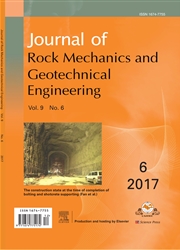

 中文摘要:
中文摘要:
Rockburst, an unstable failure of brittle rocks, has been greatly concerned in rock mechanics and rock engineering for more than 100 years. The current understanding on the mechanical mechanism of rockburst is based on the Coulomb theory, i.e. compressive-shear failure theory. This paper illustrates a series of tensile and tensile-shear fracture phenomena of rockburst, and proposes a methodology for the analysis of fracture mode and its energy dissipation process based on Griffith theory. It is believed that: (1) the fracture modes of rockburst should include compressive-shear, tensile-shear and pure tensile failures; (2) the rupture angle of rock mass decreases with the occurrence of tensile stress; (3) the proportion of kinetic energy in the released strain energy from a rockburst may be much larger than that transferred into surface energy; and (4) the understanding on the tensile and tensile-shear failure modes of rockburst may change the basic thinking of rockburst control, i.e. from keeping the reduction in initial compressive stress σ3 to restricting the creation of secondary tensile stress.
 英文摘要:
英文摘要:
Rockburst, an unstable failure of brittle rocks, has been greatly concerned in rock mechanics and rock engineering for more than 100 years. The current understanding on the mechanical mechanism of rockburst is based on the Coulomb theory, i.e. compressive-shear failure theory. This paper illustrates a series of tensile and tensile-shear fracture phenomena of rockburst, and proposes a methodology for the analysis of fracture mode and its energy dissipation process based on Griffith theory. It is believed that: (1) the fracture modes of rockburst should include compressive-shear, tensile-shear and pure tensile failures; (2) the rupture angle of rock mass decreases with the occurrence of tensile stress; (3) the proportion of kinetic energy in the released strain energy from a rockburst may be much larger than that transferred into surface energy; and (4) the understanding on the tensile and tensile-shear failure modes of rockburst may change the basic thinking of rockburst control, i.e. from keeping the reduction in initial compressive stress σ3 to restricting the creation of secondary tensile stress.
 同期刊论文项目
同期刊论文项目
 同项目期刊论文
同项目期刊论文
 Experimental study of ultrasonic waves propagating across rock mass with single joint and multiple p
Experimental study of ultrasonic waves propagating across rock mass with single joint and multiple p Influence of tunnel wall roughness and localized stress concentrations on the brittle failure of mas
Influence of tunnel wall roughness and localized stress concentrations on the brittle failure of mas 期刊信息
期刊信息
